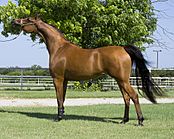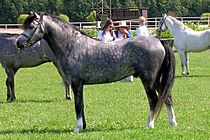Welara facts for kids
| Distinguishing features | Refined but hardy pony breed |
|---|---|
| Country of origin | Originally bred in England, registered in United States |
| Breed standards | |
| American Welara Pony Registry | Breed standards |
| Horse (Equus ferus caballus) | |
The Welara is a special type of pony! It's a mix of two beautiful horse breeds: the Arabian horse and the Welsh pony. This breed first started in England in the early 1900s. A lady named Lady Wentworth at the Crabbet Arabian Stud helped create them. She used Arabian male horses (called stallions) and Welsh pony female horses (called mares). Over time, Welara ponies became popular and spread across North America. In 1981, a special group was formed in the United States to keep track of all the Welara ponies. These ponies are great for many types of English riding and are known for being elegant, strong, and full of energy.
Contents
What Makes a Welara Pony Special?
Welara ponies come in different sizes, but they are all ponies. Male Welara ponies (stallions) are usually about 14 to 15 hands (56 to 60 inches, 142 to 152 cm) hands tall. Female Welara ponies (mares) are typically 13.1 to 14.3 hands (53 to 59 inches, 135 to 150 cm) hands tall. To be officially registered as a Welara, a pony must be between 11.2 and 15 hands (46 and 60 inches, 117 and 152 cm) hands high.
Different Types of Welara Ponies
Because Welaras are a mix of Arabians and different types of Welsh ponies, they can look a bit different.
- If a Welara has a small Welsh Pony (Section A) in its family, it's usually under 13 hands (52 inches, 132 cm) hands. These ponies are often used for light driving or for small children to ride.
- Welaras with Section B Welsh Pony blood are usually 13 to 13.2 hands (52 to 54 inches, 132 to 137 cm) hands tall. They are good for driving and for bigger kids or small adults to ride.
- Ponies with Section C Welsh Pony ancestors are often 13.2 to 14.2 hands (54 to 58 inches, 137 to 147 cm) hands tall. They tend to be a bit stronger and sometimes have a little extra hair around their feet.
- The largest Welaras have Section D Welsh Pony blood and can be 13.3 to 15 hands (55 to 60 inches, 140 to 152 cm) hands tall. These are great for average-sized adults and many different riding activities.
Colors and Features
Welara ponies can be almost any color! The only color not allowed for registration is Appaloosa. Welara Sport Ponies, which are a mix of Welara and other breeds, can be any color or size.
Welaras get their elegant look, energy, and toughness from their Arabian and Welsh ancestors. They have a small head that curves in a little bit, and their neck is often arched. Their shoulders and back end are long, but their back is short.
What Welara Ponies Do
Welara ponies are mostly used for English riding. They are very popular in hunter classes, where ponies jump over obstacles. You might also see them in show jumping, three-day eventing (which includes jumping, riding, and cross-country), pleasure driving, or just as fun horses for leisure riding. Sometimes, Welaras are mixed with Thoroughbred horses to create great ponies for hunter and jumper competitions.
How the Welara Breed Started
The idea of mixing Arabian horses and Welsh Ponys began in Sussex, England in the early 1900s. This was thanks to Lady Wentworth, who owned the famous Crabbet Arabian Stud. She started breeding Arabian stallions, like a famous one named Skowronek, with Welsh mares. She even imported some Welsh mares from a special farm in North Wales in the 1920s.
Other breeders in England and North America soon started doing the same thing. At first, they weren't trying to create a brand new breed, but the mix became known as the Welara.
The Welara Registry
In 1981, a group called the American Welara Pony Registry was created in the United States. Their goal was to help the breed grow and become more well-known. They started keeping a special book, called a studbook, to record the family trees (or pedigrees) of all the Welara ponies.
To be a purebred Welara, a pony must only have Welsh and Arabian blood. They need to have at least 1/8 (one-eighth) and no more than 7/8 (seven-eighths) of blood from each breed. In 2005, the registry had over 1,500 ponies listed in North America, with about 100 new foals added each year.
The association also registers Welara Sport Ponies. These ponies are at least half Welara but also have blood from other breeds, often the Thoroughbred. They also keep records of purebred Welsh and Arabian horses that are used to start new Welara lines.
Today, Welara ponies can be found in many parts of the world, including the Caribbean, Oceania, and Europe. In Europe, these types of Welsh/Arabian mixes are often called "riding ponies" or "sport ponies." In the US, you'll most often see them in the central and western parts of the country.




